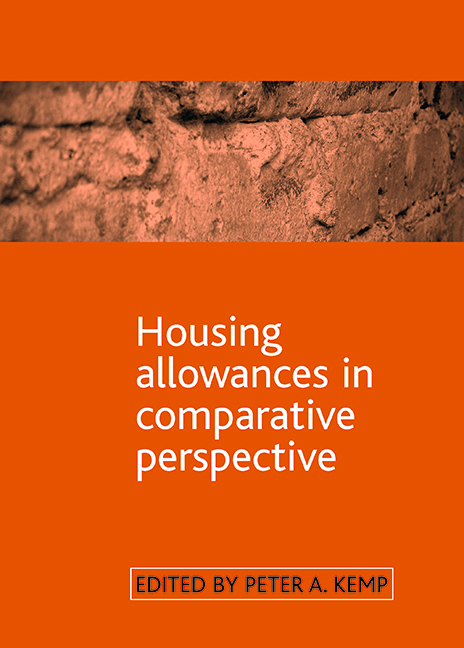Book contents
- Frontmatter
- Contents
- List of tables and figures
- Acknowledgements
- Notes on contributors
- one Housing allowances in context
- two Housing allowances and the restructuring of the Australian welfare state
- three The New Zealand experience of housing allowances
- four Canadian housing allowances
- five Housing allowances American style: the Housing Choice Voucher programme
- six Housing Benefit in Britain: a troubled history and uncertain future
- seven Housing allowances in France
- eight Housing allowances in Germany
- nine Housing allowances in the Netherlands: the struggle for budgetary controllability
- ten Housing allowance systems in Sweden
- eleven Housing allowances in the Czech Republic in comparative perspective
- twelve Housing allowances in the advanced welfare states
- Index
ten - Housing allowance systems in Sweden
Published online by Cambridge University Press: 15 September 2022
- Frontmatter
- Contents
- List of tables and figures
- Acknowledgements
- Notes on contributors
- one Housing allowances in context
- two Housing allowances and the restructuring of the Australian welfare state
- three The New Zealand experience of housing allowances
- four Canadian housing allowances
- five Housing allowances American style: the Housing Choice Voucher programme
- six Housing Benefit in Britain: a troubled history and uncertain future
- seven Housing allowances in France
- eight Housing allowances in Germany
- nine Housing allowances in the Netherlands: the struggle for budgetary controllability
- ten Housing allowance systems in Sweden
- eleven Housing allowances in the Czech Republic in comparative perspective
- twelve Housing allowances in the advanced welfare states
- Index
Summary
Introduction
Government support for housing expenditure has a long tradition in Sweden. In 1936 a means-tested housing expenditure support was introduced for families with at least three children. The support was combined with an investment support to the housing where these families lived. Originally, only rented housing was eligible. Housing expenditure support to pensioners was introduced later. In 1946 the government decided to introduce a special means-tested local government housing expenditure supplement, in addition to the existing general housing expenditure supplement, which was an addition to the general pension. The local government housing expenditure supplement was not compulsory for the local governments, but an option. Today there are three housing allowance systems in Sweden: one for households with children, one for young households and one for pensioners.
The importance of housing allowances in Sweden is shown in Table 10.1. As is clear from the table, there was a dramatic decrease in the total expenditure on housing allowances as a percentage of GDP between 1995 and 2004. The number of housing allowance recipients also decreased, from 991,000 to 632,000 during the period from 1995 to 2003, the reasons for which are discussed later in the chapter. Due to changes in other housing subsidy systems, however, expenditure on housing allowances calculated as a percentage of all housing subsidies (excluding subsidies through the tax system) increased over this period, rising from 29% in 1995 to 88% in 2004. The main explanation for the latter is the phasing-out of the guaranteed interest subsidies for investment in and renovation of housing that took place between 1992 and 2000. The guarantee system was expensive for the state, partly due to the design of the system where the government took the whole interest risk and partly because the system applied to almost all housing production. From 2002, only a tax-compensating interest subsidy is paid to rented and cooperative housing that matches owner-occupiers’ tax relief for interest payments.
Table 10.2 shows the percentage of different types of households that received housing allowances in 2002. Lone parents and pensioners are the largest group of recipients with 82% and 23% respectively of the total population getting a housing allowance.
- Type
- Chapter
- Information
- Housing Allowances in Comparative Perspective , pp. 215 - 238Publisher: Bristol University PressPrint publication year: 2007



